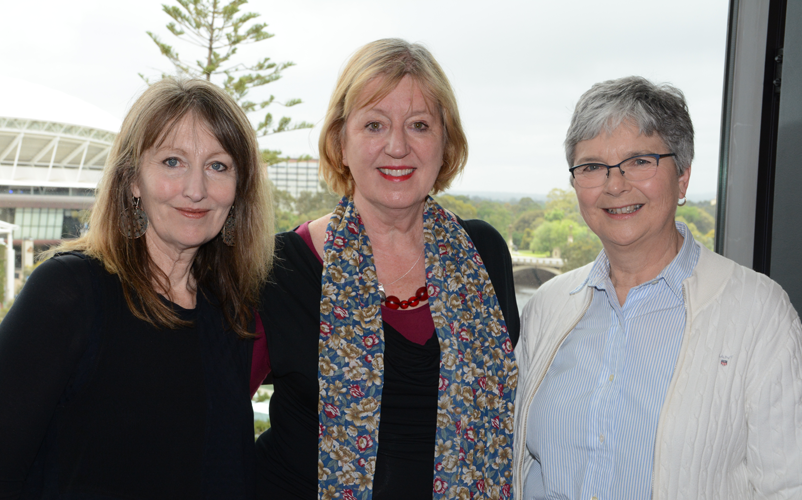A range of high quality initiatives were celebrated at the 20th Resilient Australia Awards, with a focus on child-centred disaster education and empowerment to action. The line-up of national winners featured community engagement, local government partnerships and other initiatives that captured strength in the face of disaster.
Executive Director at the Australian Institute for Disaster Resilience, Amanda Leck said the award winners illustrate exciting and creative approaches to resilience, with a high level of impact.
‘The quality of entries has been impressive. I wish to send my heartfelt thanks to all who submitted projects and photos this year, your efforts are inspiring,’ Ms Leck said.
The high quality of children’s projects suggests the crucial role they have in disaster resilience education and community strength and recovery.
Dr Robert Glasser, former Head of the UN Office for Disaster Risk Reduction, featured as the opening keynote at the Australian Disaster Resilience Conference in 2019.
‘Children have a huge role to play in reducing risk in their communities, in managing once a disaster strikes, and in helping support the recovery afterwards,’ Dr Glasser said.
New Scout badge teaches valuable, real-world skills
Sarah Hamilton was completing a training course with Scouts Western Australia when she saw clear similarities between scouting and the emergency services.
The State Emergency Service (SES) volunteer found many younger scouts were ‘intimidated’ by the amount of equipment and tools involved in an emergency or rescue operation.
To overcome this fear and develop a bridge between the two organisations, Ms Hamilton developed The SES Awareness Badge for Scouts. The badge is an introduction to the SES and communicates a Scout’s understanding of emergency operations while celebrating the shared value of public service between the two organisations.
‘I think secretly all SES members did Scouts in their youth, it’s a huge common connection, so why don’t we just establish that appropriately and have a badge and that pathway available for them?’ she asks.
Ms Hamilton built up confidence in the Scouts by linking their activities to the important work of the emergency services through their local SES unit. She also asked the Scouts what they wanted to learn from SES volunteers to help guide the development of the badge.
‘When we were trialling it, they just loved all the activities, like doing hand tools and sandbagging, lots of scouts really want to come out with us at 2 o’clock in the morning,’ Ms Hamilton said.
The SES Awareness Badge took out the 2019 Resilient Australia National Award at a ceremony in Adelaide. The awards celebrated 20 years of recognising resilience across communities, governments, businesses, schools and through photography.
Ms Hamilton was recognised for her passion for building disaster awareness and resilience at a grassroots level. She says the ‘youth-leading, adults-supporting’ approach has helped with the success of the program.
‘It’s every SES members’ dream to wear this badge,’ Ms Hamilton said.
The introduction of the SES Awareness Badge has already seen a major shift in how young Scouts are approaching their work, with over 500 recipients since its inception in April 2018.
The badge can be earned at all five youth sections – Joeys, Cubs, Scouts, Venturers and Rovers.
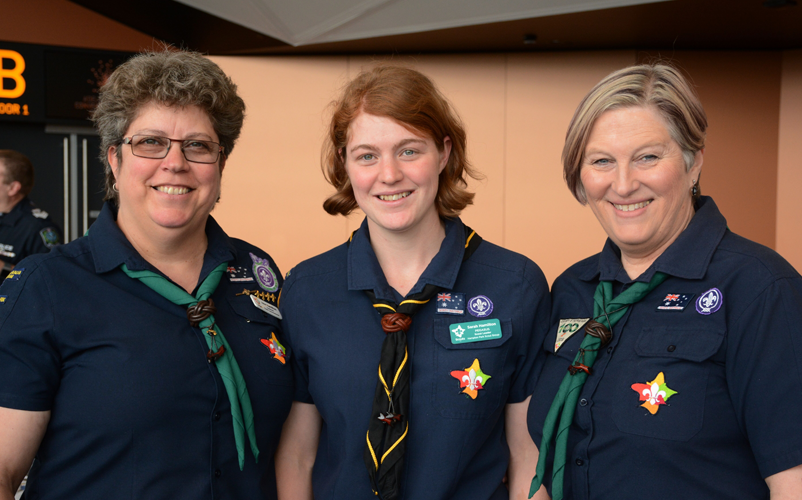
L-R: Jane Hamilton, Sarah Hamilton and Barb de la Hunty.
Image: Australian Institute for Disaster Resilience
Flood and bushfire programs receive awards
The Northern Territory Emergency Service was highly commended for their flood safe short films designed to educate the Aboriginal and Torres Strait Islander population about the importance of flood safety.
Between 1960 and 2017, at least 27 fatal floods in the Northern Territory have claimed the lives of 38 people.
To overcome the barrier of language in public safety information and flood warnings, the films are available in English as well as six local languages – Kriol, Arrernte, Kunwinku, Murrinh Patha, Warlpiri and Yolngu Matha.
The films create awareness about the dangers of entering floodwater. Remote television stations broadcast both the full and cut down versions.
NSW Rural Fire Service (RFS) also received a highly commended award for their Prepare.Act.Survive initiative, which is celebrating 10 years of risk recognition and community preparedness before a bushfire.
After the Black Saturday bushfires in Victoria, research showed only 30 per cent of Australians had a bushfire survival plan in place.
The long-serving NSW RFS public safety campaign has seen positive improvements to community responses expectations when there is a bushfire threat, with 69 per cent of communities now prepared with a bushfire survival plan in place.
Children leading in the classroom
The Sunshine Coast Regional Council took out the Local Government National Award for the ‘Get Ready Schools Program’.
In Australia’s most disaster-prone state, the Get Ready Schools Program builds on the natural hazard knowledge of young Queenslanders through an interactive learning platform. The program provides students with the skills to prepare for, respond to and recover from the impacts of disaster.
Sunshine Coast Regional Council staff deliver the program to schools across the locality and engage with upper-primary students in grades four, five and six.
In 2001, Eudlo resident, Christine Davis, bought a house on a flat block of land in a rural environment and was ‘quite surprised when it flooded’.
Through the Get Ready Schools Program, Ms Davis’s granddaughter Annaleisa has learnt about the severity of a flood in a rural environment like Eudlo.
‘Last year I wasn’t very prepared because I didn’t know much. All I knew was that rain could come down at any minute and lightning could hurt you.
‘I think I would be pretty prepared and know what to grab if I had to evacuate,’ Annaleisa said.
The program also benefits teachers who can link the program’s interactive learning activities to their humanities and social science curriculum.
‘As well as learning about natural disasters and being receivers of this knowledge, they are also able to be sharers and teachers,’ Rachel Kalle, a grade five teacher said.
Palmwoods State School has delivered the program to more than 1000 students, with a potential reach of over 4000 family, friends and community members.
Students developed a deeper understanding of natural hazards through personal recounts from local community members, creative writing activities, school camps focusing on flood mitigation and the council’s online Disaster Hub to identify at-risk areas and stay informed.
‘They’re getting it first-hand when their young and hopefully that will stay with them and they can build on that,’ Ms Davis said.
Innovative councils showcase resilience in action
The Hume City Council in Victoria and the Redland City Council in Queensland received highly commended awards at the national ceremony.
The Hume City Council welcomed over 4400 new residents from overseas in 2016. The English and Emergencies - Learn and Prepare initiative builds English literacy to help local students respond to an emergency.
The Redland City Council was recognised for its Community Champions program that encourages a community-led response to disasters, such as the North Stradbroke Island fires that threatened Russell Island in 2019. The program provided clear communication and messaging to the community, leading to positive preparedness and community responses.
The program is a joint initiative between the Redlands Coast Southern Bay Islands community and the council in partnership with Australian Red Cross, Queensland Fire and Emergency Service and Volunteering Queensland.
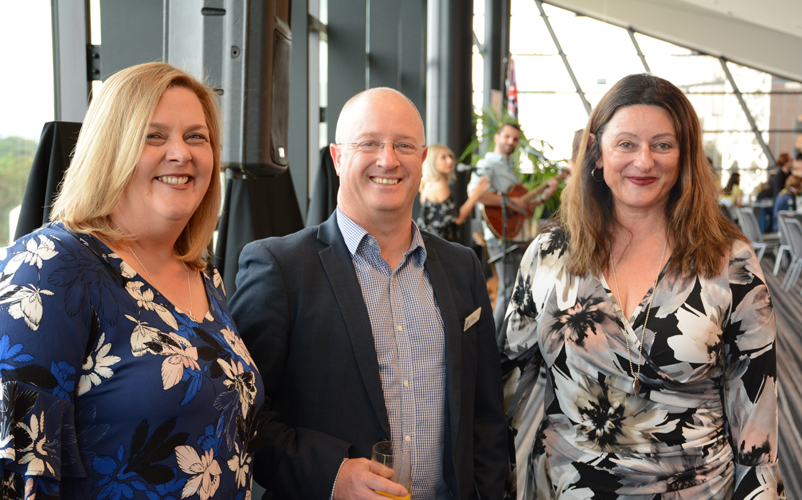
L-R: Martha Martin (Hume City Council), Steve Cameron (Emergency Management Victoria) and Tina Georgiev (Hume City Council).
Image: Australian Institute for Disaster Resilience
Youth-led education continues to shine
The power of building disaster resilience through children was again on show as students from Strathewen Primary School in Victoria took out the Resilient Australia National Schools Award.
For many years, bushfire information evenings run by the Country Fire Authority (CFA) were poorly attended, with many brochures ending in the recycling bin upon departure.
But local students have since taken the lead, sharing their past experiences of losing their school during the devastating Black Saturday bushfires.
Eleven years since the fires, the school has embraced its history and is working in partnership with the CFA to deliver an interactive and engaging outdoor bushfire education program.
‘Adults generally don’t listen to kids, so if we can tell them what we can learn at a young age, we can continue that through our life,’ said Scarlett Harrison, a student at Strathewen Primary School who was just a toddler when the fires killed 22 residents and destroyed 80 per cent of the towns buildings.
Students at the school understand fire danger ratings, fire behaviour, environmental influences and risk factors.
Dr Briony Towers, who researches child-centred disaster education at RMIT University and the Bushfire and Natural Hazards CRC, says the program has long-term effects, rather than being a ‘one off’.
‘The benefit of this program is that it has really become part of the school culture,’ Dr Towers said.
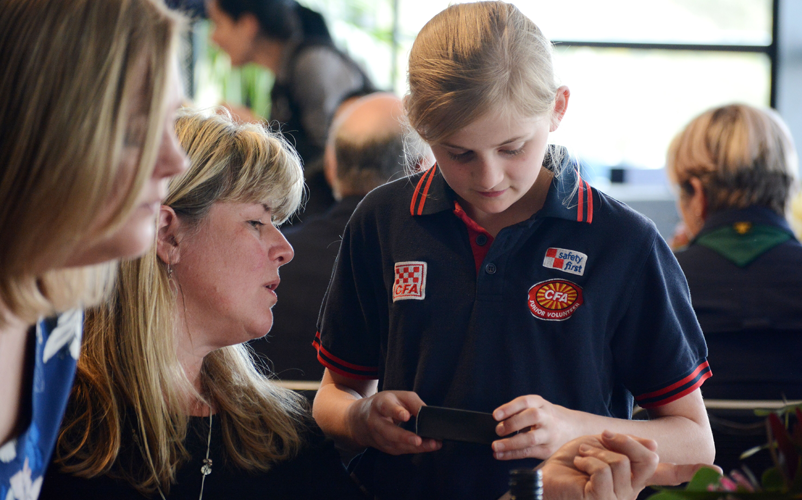
L-R: Lisal O’Brien (Country Fire Authority) and Scarlett Harrison (Strathewen Primary School Student).
Image: Australian Institute for Disaster Resilience
Schoolyard resilience on display
The school mural at Swayneville State School received a highly commended award at the Resilient Australia Award ceremony. When Cyclone Debbie destroyed the main access road into the small, rural community of Sarina Range in 2017, a temporary school campus was established at the top of the town.
Students designed and created a mural to illustrate their strength after the cyclone and connect the two school campuses. The mural serves as a positive reminder of the student’s resilience, providing a fitting backdrop for school photos and a positive talking point for visitors.
Tathra Public School students showcased their resilience through words and imagery after a devastating bushfire in March 2018 destroyed almost 70 homes in their town. The school produced a picture book, When the fire met the sea, written and illustrated by students at the school.
The school was in the direct line of the fire front. Burnt trees, ash-smothered classrooms and a destroyed playground stood as the physical remnants of the event.
The book features poems, stories and vivid artwork about the students’ experiences during the fire and is a historical reminder of their resilience. A copy of the book is in the National Library of Australia in Canberra with other copies available for sale to raise further funds for the school.
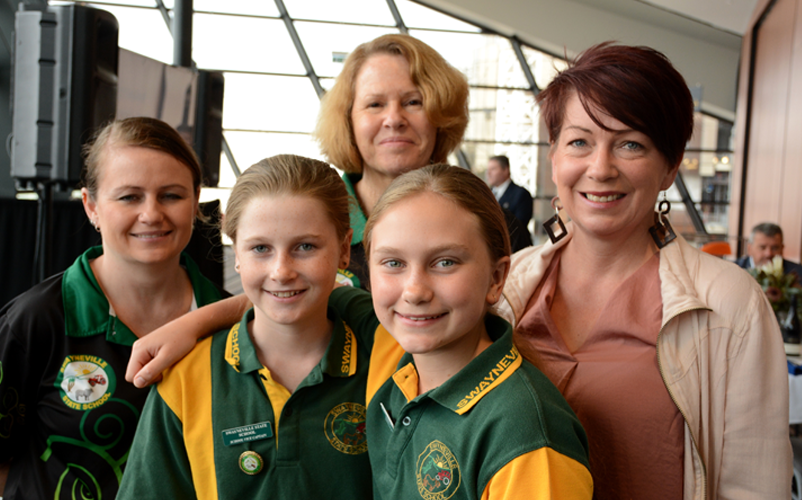
L-R: Leah Mullane (Swayneville School Principal), Jordannah Moren (Student), Wendy Robinson (Teacher), Maddelyn Eames (Student), and Jodie Connolly (Artist).
Image: Australian Institute for Disaster Resilience
Emotional resilience in photography category
James Spencer received the Resilient Australia National Photography Award for his image of Tasmanian resident Dale ‘Hairyman’ Fullard, who is pictured sitting along the Huon River.
Mr Fullard lost his property during the Tasmanian bushfires in early 2018.
‘I remember shutting my house door and then I actually said goodbye to it, not knowing if I’d see it again.
‘It was a strange feeling to walk away and not know what you might come back to,’ Mr Fullard said.
He says the most horrible part was coming back and seeing the bare ground.
‘It’s amazing how disasters bring communities together,’ Mr Fullard said.
Photographer James Spencer says he did not think twice about taking Dale’s photo and sharing his story.
‘Nothing says resilience more than someone who’s carrying on with their life after such a massive loss like that.
‘It’s a good attitude to have,’ Mr Spencer says.
The award winning photograph is the cover of January 2020 edition of the Australian Journal of Emergency Management.
Dr Marta Yebra was honoured with a highly commended award for her aerial photography after the Pierces Creek fire in the Australian Capital Territory.
Dr Yebra’s photograph illustrates the effect of climate change, with the fire taking place before the traditional start to the bushfire season.
Lurline Byles also received a highly commended award for her image of Clydesdale Jemima and her owner and volunteer, Claire Curr.
Jemima was rescued as a foal during Black Saturday but is now part of the Department of Fire and Emergency Services mounted section, where she is involved in multiple searches to assist police in locating and reuniting missing loved ones with their families.
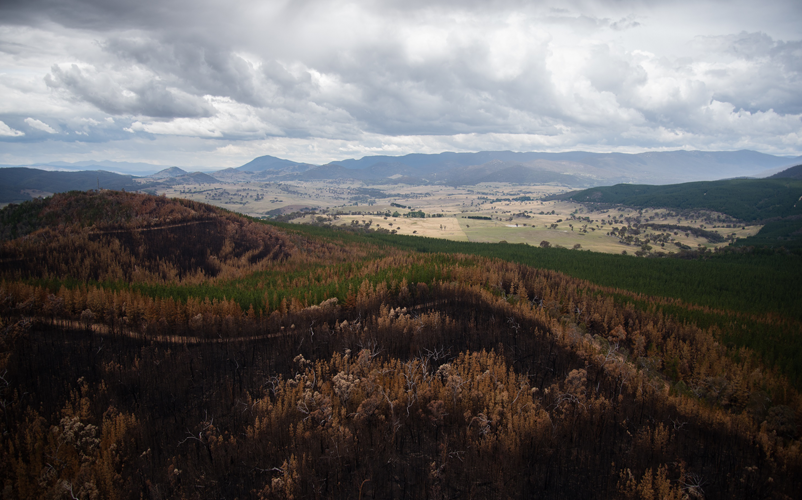
This aerial photograph shows the environmental damage from the Pierces Creek fire, which burned through Canberra’s west.
Image: Marta Yebra
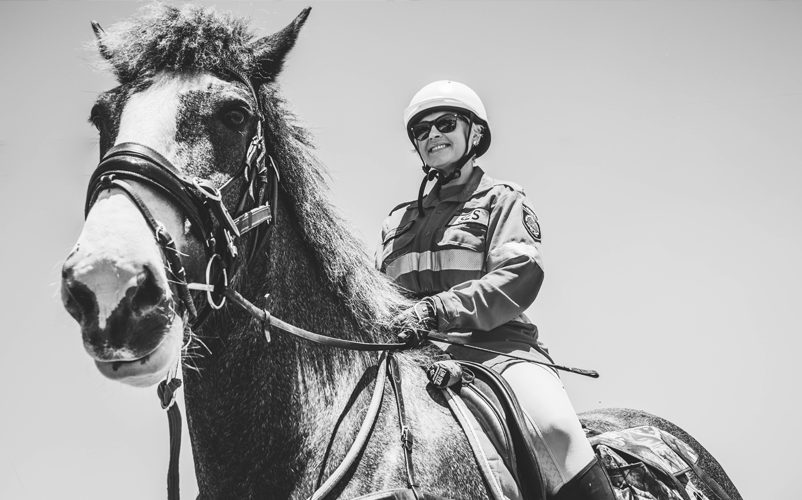
Rescued as a foal during Black Saturday, Clydesdale Jemima is helping local police with search and rescue operations with her owner and volunteer Claire Curr.
Image: Lurline Byles
Domestic violence and child-centred trauma initiatives
Disasters can increase the prevalence of domestic violence and mental health complications for children. Two nationally significant programs that addressed these concerns were highlighted at the 20th Resilient Australia National Awards.
Natural hazards and emergencies can provoke a range of traumatic experiences and responses for individuals, couples and families.
Climate change brings with it an increase in the frequency and severity of natural hazards. As a consequence, communities at increased risk of these hazards are likely to be at an increased risk of mental health complications and problematic behaviour in the aftermath.
Two initiatives help bridge the gap between natural hazards and their consequences by providing research-informed training and resources to emergency services and communities.
Emerging Minds has worked alongside the Australian National University to develop the Community Trauma Toolkit; a collection of trauma-centred mental health resources tailored to the needs of children.
Likewise, the Gender and Disaster (GAD) Pod has developed interactive training packages designed to break down gender and communication barriers to reduce the risk of domestic violence following disasters.
Both initiatives received a special honour at the national awards for their significant contributions to recovery and resilience.
The awards were celebrated at a national ceremony held at the Adelaide Convention and Exhibition Centre, where projects from across Australia were acknowledged.
Australian Institute for Disaster Resilience (AIDR) Executive Director Amanda Leck was impressed by the submissions entered in the awards.
‘We were so overwhelmed by the quality of the work, the judges decided to recognise two special projects for their national significance in addition to the National Award.
‘We continue to be in awe of the creativity and community spirit we see in the applications,’ Ms Leck said.
The awards received a record-breaking number of submissions across business, local government, school, community, government and photography categories.
Children’s mental health in the spotlight
Up to 43 per cent of children who have been exposed to some degree of trauma will develop post-traumatic stress disorder, with some experiencing anxiety, depression and other health disturbances.
Natural hazards and exposure to other traumatic events can increase the risk of serious and long-term consequences for a child’s wellbeing.
The Community Trauma Toolkit is a comprehensive trauma-informed approach to educate employees and families about infant and child mental health in the context of disasters.
The toolkit provides a range of resources divided by audience. It equips parents, educators, operational personnel and health and social service providers with the skills and knowledge to support children before, during and after disaster. To best support their implementation, the resources are designed for flexible delivery options.
Nicola Palfrey leads the project through the Australian Child and Adolescent Trauma, Loss and Grief Network at the Australian National University. The program provides free access to vital experience and expertise.
‘It pulls together the wisdom and knowledge of individuals who have lived through disaster, expert clinicians and research to provide clear, accessible information for families and professionals.
‘It addresses a gap in drawing together this information in one place and focusing on children under 12 years of age who are particularly vulnerable to the impacts of community trauma events,’ Ms Palfrey says.

Nicola Palfrey from the Emerging Minds team.
Image: Australian Institute for Disaster Resilience
The toolkit allows users to choose between five timelines: preparedness, immediate, short term, long term and ongoing. Each module provides advice and information about how children may experience mental health impacts during each time period.
- Preparedness: this entails educating children about the risks in their immediate area and including children in preparedness plans and family meetings.
- Immediate: this focuses on the immediate four weeks following a disaster. It encourages comfort for children, limited media coverage and providing a safe space for children to talk about their feelings.
- Short term: in the immediate months following a traumatic event, parents are encouraged to be patient, maintain stability and allow children to recover.
- Long term: in the four or more months following a disaster, adults are encouraged to support children to find their ‘new normal’ but should be aware of event anniversaries or reminders.
- Ongoing: these resources focus on disasters like droughts, which can trigger a child’s mental health for months or years following exposure to a traumatic event.
In addition to over 100 written resources, videos and podcasts, the toolkit includes a series of training modules tailored to different audiences and their engagement with children during disaster.
The first responders training program focuses on simple and practical strategies for emergency service personnel to support children experiencing stress and trauma during an emergency.
The community training sessions focus on disaster preparedness and understanding trauma. These sessions aim to build community connectedness and resilience at a grassroots level. The customisable nature of the toolkit allows communities around Australia to receive the information in a clear and relevant way.
The organisation community training is delivered in workplaces, such as Save the Children in South Australia, Australian Red Cross and Uniting Church. The training leverages off the resources already employed throughout the communities they serve.
Ms Palfrey described the award as a ‘wonderful recognition’.
‘It is an acknowledgment of the importance of children and their wellbeing, and the willingness of workforces and communities to want to learn more about supporting children,’ Ms Palfrey says.
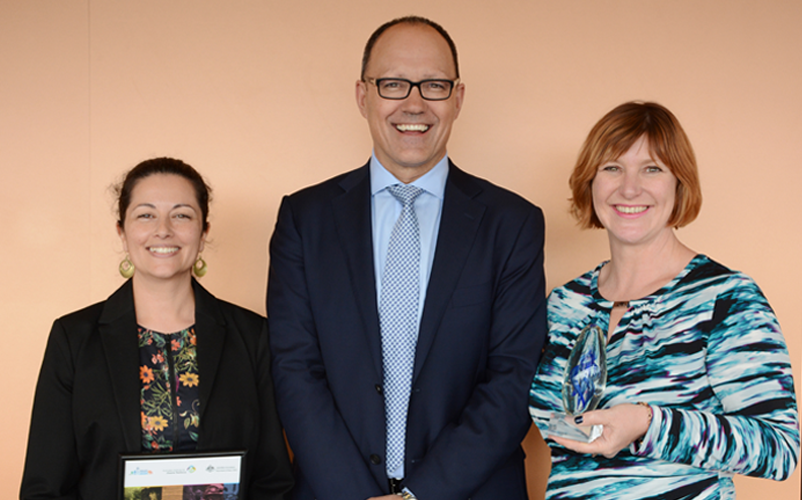
L-R: Laura Gooyers, Hon. Corey Wingard MP, Nicola Palfrey.
Image: Australian Institute for Disaster Resilience
Addressing domestic violence after a disaster
One in six Australians are likely to be exposed to a disaster in their lifetime, but men and women will experience these disasters differently.
A Victorian initiative is helping emergency services organisations to understand and address domestic violence concerns following disaster with practical strategies for gendered considerations in emergency management policy, planning, decision making and service delivery.
The GAD Pod is an initiative of two Victorian women’s health organisations; Women’s Health in Goulburn North East and Women’s Health in the North, and the Monash University Disaster Resilience Initiative.
The face-to-face education and training resources, which include two comprehensive training packages and a train-the-trainer package, was acknowledged with the 2019 Resilient Australia National Significance Award.
The program was recognised for its innovative and interactive approach to breaking down the barriers, behaviours and attitudes between men and women after a disaster.
Over 400 emergency management personnel have taken part in the training across 25 sessions, including representatives from the Metropolitan Fire and Emergency Services Board; Country Fire Authority; the Victorian Department of Environment, Land, Water and Planning; Victorian State Emergency Service personnel and volunteers as well as police, local government staff and community members.
Dr Debra Parkinson leads the project and said receiving a Resilient Australia National Award represents a pivotal occasion for her team.
‘This award recognises the national significance of the increased domestic violence after disasters, and the relevance of it to disaster resilience and the emergency management sector.
‘This prestigious award will further enhance understanding and action on family violence in disasters, and nationwide awareness of the Gender and Emergency Management Guidelines,’ Dr Parkinson said.
The training has also taken place in Tasmania, where 11 middle and senior emergency managers took part. The Inspector-General of Emergency Management Queensland and Australian Red Cross also partnered to deliver the program in relation to domestic and family violence.
The program focuses on the gaps in research and community behaviour. The initial research phase involved men and women who survived the 2009 Black Saturday bushfires in Victoria, which claimed 173 lives. Many Victorian communities continue to experience trauma and mental health complications associated with the event.
The research uncovered that men suffered from mental health issues and women experienced domestic violence following Australia’s most devastating bushfire disaster.
‘This award is shared by the women and men who told us about the worst times in their lives during and after Black Saturday.
‘It was a big risk for women and men to step away from society’s expectations and speak of the pressure they felt from gendered expectations, and the damage that resulted,’ Dr Parkinson said.
The training materials also incorporate findings from the All on Board project, which sought to reduce the compounding effects of gender on disaster impact by filling the gaps in knowledge, policy and practice.
The study examined gendered expectations in the aftermath of disaster. While men are expected to protect and provide, women are expected to nurture and care for others.
‘Society wants to believe in the myths of strong, silent and stoic men, and women who support their men,’ Dr Parkinson said.
The research consulted over 350 emergency management personnel from around Australia to create a literature review and a companion checklist. The checklist focuses on inclusive attitudes towards women and the LGBTIQ+ community.
The interactive GAD Pod sessions bring the research to life by sharing local and international resources about family violence after a disaster. Each session focuses on the challenges faced by men and considers the planning, response and recovery phases of a disaster.
Part of the GAD Pod training modules educate emergency management personnel about the importance of referring women to the services and support they need in emergencies and after disasters.
It also supports men to break down traditional ideas of masculinity and access help in the community or workplace.
Parts of the program are targeted towards boys and girls to eliminate an upbringing with gendered expectations. Through the removal of these expectations, harmful behaviours after disasters and in emergency situations can be monitored and removed over time.
The project leader said ‘so much has changed’ since the team began the research and the message is catching on across the state. The GAD Pod’s ‘Disaster is no excuse for violence’ postcard has also been influential, with over 30,000 postcards circulated to organisations throughout Victoria in 2019 alone.
Domestic violence and emergency management is on the policy agenda following the development of the National Gender and Emergency Management Guidelines by the Attorney-General’s Department. The guidelines serve as a starting point for conversations, reform and understanding.
